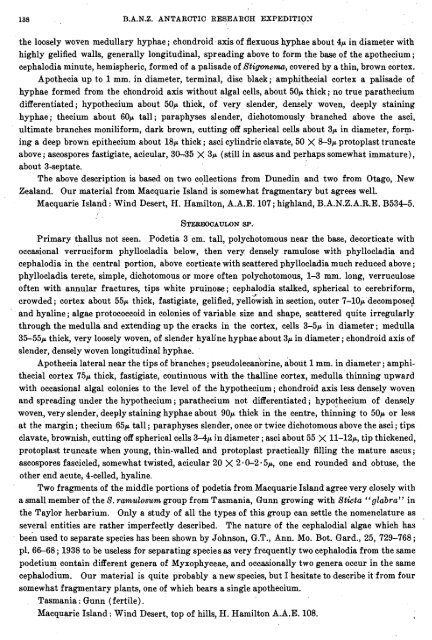Create successful ePaper yourself
Turn your PDF publications into a flip-book with our unique Google optimized e-Paper software.
138 B.A.N.Z. ANTARCTIC 13ESEABCH EXPEDITION<br />
the loosely woven medullary hyphae ; chondroid axis of flexuous hyphae about 4p in diameter with<br />
highly gelified walls, generally longitudinal, spreading above to form the base of the apothecium ;<br />
cephalodia minute, hemispheric, formed of a palisade of Stigvnemai covered by a thin, brown cortex.<br />
Apothecia up to 1 mm. in diameter, terminal, disc black; amphithecial cortex a palisade of<br />
hyphae formed from the chondroid axis without algal cells, about 50p thick; no true paratheciunl<br />
differentiated; hypothecium about 50p thick, of very slender, densely woven, deeply staining<br />
hyphae; thecium about 6OP tall; paraphyses slender, dichotomously branched above the asci,<br />
ultimate branches moniliform, dark brown, cutting off spherical cells about 3p in diameter, forming<br />
a deep brown epithecium about 18p thick ; asci cylindric clavate, 50 X &9c( protoplast truncate<br />
above ; ascospores fastigiate, acicular, 30-35 X 3~4 (still in ascus and perhaps somewhat immature),<br />
about 3-septate.<br />
The above description is based on two collections from Dunedin and two from Otago, New<br />
Zealand. Our material from Macquarie ~sland is somewhat fragmentary but agrees well.<br />
Macquarie Island : Wind Desert, H. Hamilton, A.A.E. 107 ; highland, B.A.N.Z.A.R.E. B534-5.<br />
STEREOCAULON SP.<br />
Primary thallus not seen. Podetia 3 cm. tall, polychotomous near the base, decorticate with<br />
occasional verruciform phyllocladia below, then very densely ramuIose with phyllocladia and<br />
cephalodia in the central portion, above corticate with scattered phyllocladia much reduced above ;<br />
phyllocladia terete, simple, dichotomous or more often polychotomous, 13 mm. long, verruculose<br />
often with annular fractures, tips white pruinose; cephalodia stalked, spherical to cerebriform,<br />
crowded; cortex about 55p thick, fastigiate, gelified, in section, outer 7-lop decomposed<br />
and hyaline ; algae protococcoid in colonies of variable size and shape, scattered quite irregularly<br />
through the medulla and extending up the cracks in the cortex, cells 3-5c( in diameter ; medulla<br />
35-55p thick, very loosely woven, of slender hyaline hyphae about 3c( in diameter ; chondroid axis of<br />
slender, densely woven longitudinal hyphae.<br />
Apothecia lateral near the tips of branches ; pseudolecanorine, about 1 mm. in diameter ; amphithecial<br />
cortex 75p thick, fastigiate, coiitinuous with the thalline cortex, medulla thinning upward<br />
with occasiona1 algal colonies to the level of the hypothecium; chondroid axis less densely woven<br />
and spreading under the hypothecium ; parathecium not differentiated ; hypothecium of densely<br />
woven, very slender, deeply staining hyphae about 90c( thick in the centre, thinning to 50p or less<br />
at the margin; thecium 65p tall; paraphyses slender, once or twice dichotomous above the asci; tips<br />
clavate, brownish, cutting off spherical cells 34p in diameter ; asci about 55 X 11-12c(, tip thickened,<br />
protoplast truncate when young, thin-walled and protoplast practically filling the mature ascus ;<br />
ascospores fascicled, somewhat twisted, acicular 20 X 2.0-2-5p, one end rounded and obtuse, the<br />
other end acute, 4-celled, hyaline.<br />
Two fragments of the middle portions of podetia from Macquarie Island agree very closely with<br />
a small member of the 8. ramulosz~m group from Tasmania, Gunn growing with Sticta "glabra" in<br />
the Taylor herbarium. Only a study of all the types of this group can settle the nomenclature as<br />
several entities are rather imperfectly described. The nature of the cephaIodia1 algae which has<br />
been used to separate species has been shown by Johnson, G.T., Ann. Mo. Bot. Gard., 25, 729-768 ;<br />
pl. 66-68 ; 1938 to be useless for separating species as very frequently two cephalodia from the same<br />
podetium contain different genera of Myxophyceae, and occasionally two genera occur in the same<br />
cephalodium. Our material is quite probably a new species, but I hesitate to describe it from four<br />
somewhat fragmentary plants, one of which bears a single apothecium.<br />
Tasmania : Gunn (fertile).<br />
Macquarie Island : Wind Desert, top of hills, H. Hamilton A.A.E. 108.

















